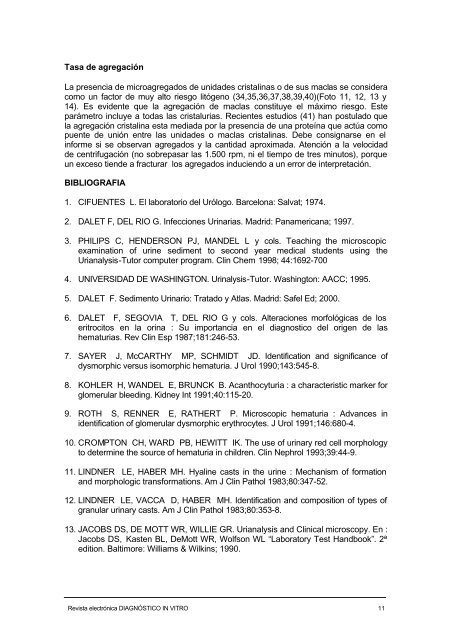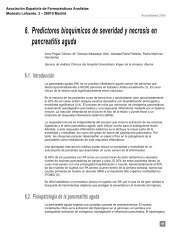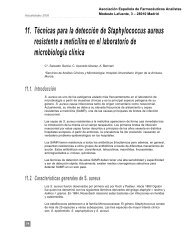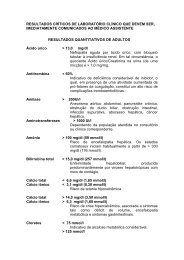EL SEDIMENTO URINARIO : ¿QUÉ HAY DE NUEVO EN ... - PNCQ
EL SEDIMENTO URINARIO : ¿QUÉ HAY DE NUEVO EN ... - PNCQ
EL SEDIMENTO URINARIO : ¿QUÉ HAY DE NUEVO EN ... - PNCQ
Create successful ePaper yourself
Turn your PDF publications into a flip-book with our unique Google optimized e-Paper software.
Tasa de agregación<br />
La presencia de microagregados de unidades cristalinas o de sus maclas se considera<br />
como un factor de muy alto riesgo litógeno (34,35,36,37,38,39,40)(Foto 11, 12, 13 y<br />
14). Es evidente que la agregación de maclas constituye el máximo riesgo. Este<br />
parámetro incluye a todas las cristalurias. Recientes estudios (41) han postulado que<br />
la agregación cristalina esta mediada por la presencia de una proteína que actúa como<br />
puente de unión entre las unidades o maclas cristalinas. Debe consignarse en el<br />
informe si se observan agregados y la cantidad aproximada. Atención a la velocidad<br />
de centrifugación (no sobrepasar las 1.500 rpm, ni el tiempo de tres minutos), porque<br />
un exceso tiende a fracturar los agregados induciendo a un error de interpretación.<br />
BIBLIOGRAFIA<br />
1. CIFU<strong>EN</strong>TES L. El laboratorio del Urólogo. Barcelona: Salvat; 1974.<br />
2. DALET F, D<strong>EL</strong> RIO G. Infecciones Urinarias. Madrid: Panamericana; 1997.<br />
3. PHILIPS C, H<strong>EN</strong><strong>DE</strong>RSON PJ, MAND<strong>EL</strong> L y cols. Teaching the microscopic<br />
examination of urine sediment to second year medical students using the<br />
Urianalysis-Tutor computer program. Clin Chem 1998; 44:1692-700<br />
4. UNIVERSIDAD <strong>DE</strong> WASHINGTON. Urinalysis-Tutor. Washington: AACC; 1995.<br />
5. DALET F. Sedimento Urinario: Tratado y Atlas. Madrid: Safel Ed; 2000.<br />
6. DALET F, SEGOVIA T, D<strong>EL</strong> RIO G y cols. Alteraciones morfológicas de los<br />
eritrocitos en la orina : Su importancia en el diagnostico del origen de las<br />
hematurias. Rev Clin Esp 1987;181:246-53.<br />
7. SAYER J, McCARTHY MP, SCHMIDT JD. Identification and significance of<br />
dysmorphic versus isomorphic hematuria. J Urol 1990;143:545-8.<br />
8. KOHLER H, WAND<strong>EL</strong> E, BRUNCK B. Acanthocyturia : a characteristic marker for<br />
glomerular bleeding. Kidney Int 1991;40:115-20.<br />
9. ROTH S, R<strong>EN</strong>NER E, RATHERT P. Microscopic hematuria : Advances in<br />
identification of glomerular dysmorphic erythrocytes. J Urol 1991;146:680-4.<br />
10. CROMPTON CH, WARD PB, HEWITT IK. The use of urinary red cell morphology<br />
to determine the source of hematuria in children. Clin Nephrol 1993;39:44-9.<br />
11. LINDNER LE, HABER MH. Hyaline casts in the urine : Mechanism of formation<br />
and morphologic transformations. Am J Clin Pathol 1983;80:347-52.<br />
12. LINDNER LE, VACCA D, HABER MH. Identification and composition of types of<br />
granular urinary casts. Am J Clin Pathol 1983;80:353-8.<br />
13. JACOBS DS, <strong>DE</strong> MOTT WR, WILLIE GR. Urianalysis and Clinical microscopy. En :<br />
Jacobs DS, Kasten BL, DeMott WR, Wolfson WL “Laboratory Test Handbook”. 2ª<br />
edition. Baltimore: Williams & Wilkins; 1990.<br />
Revista electrónica DIAGNÓSTICO IN VITRO 11





